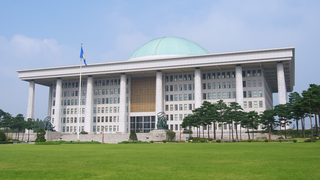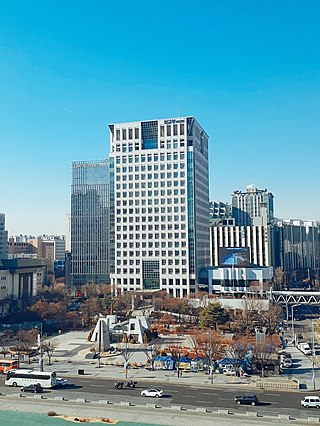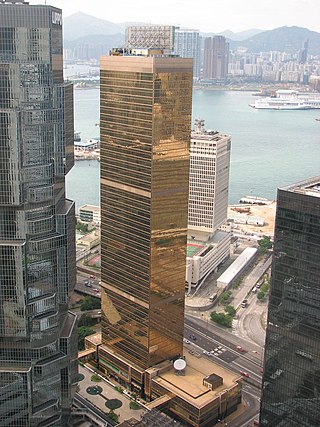A mail-order bride is a woman who lists herself in catalogs and is selected by a man for marriage. In the twentieth century, the trend primarily involved women living in developing countries seeking men from more developed nations. Men who list themselves in such publications are referred to as "mail-order husbands", although this is much less common. As of 2002, there were an estimated 100,000–150,000 mail order brides worldwide.
Dual intent is a concept in United States immigration law. Typically, it refers to the fact that certain U.S. visas allow foreigners to be temporarily present in the U.S. with lawful status and immigrant intent. This allows those visa holders to enter the U.S. while simultaneously seeking lawful permanent resident status at a port of entry. Otherwise, visa holders may be presumed to have immigrant intent and can be kept from entry as a matter of law.

South Korean nationality law (Korean: 국적법) details the conditions in which an individual is a national of the Republic of Korea (ROK), commonly known as South Korea. Foreign nationals may naturalize after living in the country for at least five years and showing proficiency in the Korean language. All male citizens between the ages of 18 and 35 who are able-bodied and mentally competent are required to perform at least 18 months of compulsory military service or alternative civilian service.
Prostitution in South Korea is illegal, but according to The Korea Women's Development Institute, the sex trade in Korea was estimated to amount to 14 trillion South Korean won in 2007, roughly 1.6% of the nation's GDP. According to a survey conducted by the Department of Urology at the Korea University College of Medicine in 2015, 23.1% of males and 2.6% of females, aged 18–69, had sexual experience with a prostitute.

The tourism industry in South Korea caters to both foreign and domestic tourists. In 2012, 11.1 million foreign tourists visited South Korea, making it the 20th most visited country in the world, and the 5th most visited in Asia. Most non-Korean tourists come from other parts of East Asia such as Japan, mainland China, Taiwan, and Hong Kong. The recent popularity of Korean popular culture, often known as the "Korean Wave", in these countries has increased tourist arrivals. Seoul is the principal tourist destination for visitors; popular tourist destinations outside of Seoul include the major coastal city of Busan, the Seorak-san national park, the historic city of Gyeongju and subtropical Jeju Island.

Visitors to the United States must obtain a visa from one of the U.S. diplomatic missions unless they are citizens of one of the visa-exempt or Visa Waiver Program countries.
The College Scholastic Ability Test or CSAT, also abbreviated Suneung, is a standardized test which is recognized by South Korean universities. The Korea Institute of Curriculum and Evaluation (KICE) administers the annual test on the third Thursday in November. In 2020, however, it was postponed to the first Thursday in December, due to the COVID-19 pandemic.
Immigration to South Korea is low due to restrictive immigration policies resulting from strong opposition to immigrants from the general Korean public. However, in recent years with the loosening of the law, influx of immigrants into South Korea has been on the rise, with foreign residents accounting for 4.9% of the total population in 2019. Between 1990 and 2020, South Korea's migrant population has grown 3,896%, second highest level of growth in the world.

South Korea's Ministry of Foreign Affairs is in charge of the country's foreign relations, as well as handling matters related to overseas Korean nationals. It was established on 17 July 1948.

South Korean–Taiwan relations

South Korea–Ukraine relations are foreign relations between South Korea and Ukraine. Diplomatic Relations were established on February 10, 1992. South Korea has an embassy in Kyiv. Ukraine has an embassy in Seoul.

The Southern Africa region experiences a relatively high influx of immigration into South Africa. As of 2019, the immigration rate is continuing to increase, and the role of the female population of migrants is significantly growing in this movement and settlement. The majority of immigrants are working residents and influence the presence of several sectors in South Africa. The demographic background of this group is diverse, and the countries of origin mainly belong to Sub-Saharan Africa and push migration south. A portion have qualified as refugees since the 1990s.

The visa policy of Hong Kong deals with the requirements in which a foreign national wishing to enter Hong Kong through one of the 15 immigration control points must meet to obtain an entry permit or Visa, which depending on the traveller's nationality, may be required to travel to, enter, and remain in the Hong Kong Special Administrative Region. Visitors from over 145 countries are permitted without Visa entry for periods ranging from 7 to 180 days, to the Hong Kong Special Administrative Region for tourism or certain business-related activities. All visitors must hold a passport valid for more than 1 month.

In South Korea, immigration policy is handled by the immigration services of the Ministry of Justice, Ministry of Labor, Ministry of Health and Welfare and the Ministry of Foreign Affairs and Trade. The Nationality Act, Immigration Control Act, Multicultural Families Support Act, and the Framework Act on Treatment of Foreigners are the foundations of immigration policy in Korea. The Korean government initiated a discussion in 2003 on establishing an independent immigration office to accommodate fast-growing immigrant and to prepare inclusive and rational immigration policies; however, there has been little progress. The Foreigner Policy Committee, headed by the Prime Minister, coordinates foreigner-related policies which were handled by many ministries. However, its role is limited because of a shortage of resources and manpower. The establishment of an Immigration Office is expected to solve these problems by concentrating all related resources and manpower under one umbrella.
The visa policy of South Korea allows citizens of certain countries to enter South Korea without a visa (Korea Electronic Travel Authorization or without a K-ETA at all.
Korea have always been a highly ethnically and linguistically homogeneous nation, however some minorities in Korea exist. Since recent decades, South Korea has become home to a number of foreign residents (4.9%), whereas isolated North Korea has not experienced this trend.

Pakistan–South Korea relations refers to bilateral diplomatic relationship between Pakistan and South Korea. Since the 1980s, the relations between the two Asian states have improved and periodically enhanced. Pakistan has an embassy in Seoul, South Korea, and South Korea has an embassy in Islamabad, Pakistan. Pakistan is one of the few countries that has good relations with both North Korea and South Korea.

According to the Japanese Ministry of Justice, the number of foreign residents in Japan has steadily increased in the post Second World War period, and the number of foreign residents was more than 2.76 million at the end of 2022. Being a country with a total estimated population of 125.57 million in 2020, the resident foreign population in Japan amounts to approximately 2.29% of the total population.
The Korean Government Scholarship Program, or KGSP, is an academic scholarship funded and managed by the National Institute for International Education (NIIED), a branch of the Ministry of Education in South Korea. This scholarship provides non-Korean scholars with the funding and opportunity to conduct undergraduate or postgraduate level studies in South Korea after completing one year of intensive Korean language studies. Since its conception in 1967, over 3,000 students from 148 countries have successfully completed the scholarship program.

The Consulate General of South Korea in Hong Kong is a consular mission of the Republic of Korea (ROK) to Hong Kong and Macau. It is located at 5-6F, Far East Finance Center 16, Harcourt Road, Admiralty, Hong Kong. It is one of the first South Korean overseas missions since the country's foundation, opened in British Hong Kong under approval of the United Kingdom in 1949, going through promotion and expansion in its history. Following the Transfer of sovereignty over Hong Kong to China in 1997, the Consulate General was able to keep its presence according to a Sino-Korean agreement concerning foreign missions stationed in Hong Kong.